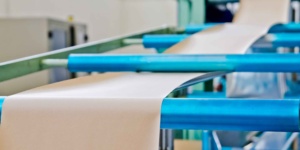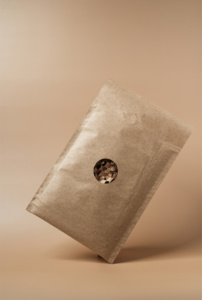
Packaging burdens the environment already during production, where not only valuable raw materials, energy, and water are consumed, but also large amounts of carbon dioxide are released into the atmosphere. Disposal is also problematic, as many raw materials are non-degradable. According to the WWF, nature takes 400 years to break down plastic.
Nature knows better packaging: fruits grow in shells or pods that protect them from moisture; apples develop a wax layer that makes them last longer; eggs are protected from the penetration of germs by their calcareous shell; A coconut survives the fall from the tree from considerable heights due to its thick shell.
Buzzwords such as the ozone layer and recycling led to a rethink in the packaging industry as early as the late 1980s.
Today, used packaging is not considered waste but is a material for further processing.
The focus is on the environmental balance, which takes into account the path of materials from raw material extraction through production and transport to their disposal.
Goals of environmentally friendly packaging
In addition to models for reducing packaging material, its environmentally friendly disposal is important.
The focus is on degradation or compostability, recycling, and other recycling options.
Compostability
Just as the apple peel rots on the home compost, so too are packaging made from purely organic materials such as wood or cardboard fully biodegradable. In this process, microorganisms dissolve the material into components such as carbon, oxygen, hydrogen, and other minerals. In industrial composting plants, they turn into compost within a few months.
Degradability
Some plastics are also biodegradable. Their chemical structure is crucial in this regard. Many food packaging materials also contain substances that are biodegradable and compostable, as well as materials that only partially consist of biomass. These bioplastics may contain fossil additives and are referred to as “bio-based”. Bio-based materials include:
- Polyactide (PLA): produced through a multistage synthesis from sugar
- Cellulose esters (CA): thermoplastic resins made from wood
- Polyhydroxyalkanoate (PHA): polyester synthesized with the help of bacteria
Recyclability
Packaging is recyclable when new materials, so-called secondary raw materials, can be made from their base materials (recycling):
Plastic is mechanically crushed and melted. However, this is only economical for pure plastics such as PET reusable bottles.
Aluminium can also be recycled without loss of quality, as long as it is pure.
The advantage: recycling requires less energy than producing the same quantities of aluminium.
Paper is recyclable with less water and energy than is necessary for its production. According to WWF, 2 kg of wood can be saved per kilogram of recycled paper, most of which comes from virgin forest areas.
Composite materials made of plastic, aluminium, and paper must be separated into pure materials before recycling, which is very labor-intensive. A more cost-effective alternative is thermal recycling: The materials are burned. The energy released in the process can be used to generate heat and electricity.
Why packaging at all?

kraft paper doypack
Packaging primarily serves to protect food. They prevent spoilage by contact with external substances: light reduces the vitamin content; moisture promotes mold growth, heat causes rot. Therefore, food packaging must meet certain barrier properties:
- Milk retains nutrients and flavor in lightproof packaging
- Meat needs protection from oxygen to prevent it from discoloring and becoming tough
- Coffee, tea, and spices retain their aromas in airtight packaging
- Sugar, flour, and other powders need protection from contamination
- Packaged fruit and vegetables are more hygienic and safe from unauthorized snackers in the store
- Wine bottles can be transported safely in wooden crates
In addition, packaging also has practical benefits:
- Flour, sugar, salt, dried peas, or rice can only be portioned and stacked for transport or storage with suitable packaging
- Multiple beverage bottles are only easily carried in packs
- Packaging serves as a medium for consumer information, such as ingredients or origin labels
- Printable materials play a crucial role in marketing
With the help of packaging, products can be better handled, transported, and stored more space-efficiently. But they are not only useful; they are also enormously important for the shelf life of the packaged goods. Furthermore, packaging, particularly since the onset of the COVID-19 crisis, has become even more significant due to increased hygiene awareness.
Bashing packaging is therefore not a solution. It would be more sensible, for example, to replace plastic with paper, which has a better environmental footprint. However, many barrier requirements – at least for now – can only be met with plastic. Further research must be conducted to make packaging more environmentally friendly. The challenges faced are evident when looking at packaging films as an example.
Challenges for the packaging industry using the example of packaging films
Eine der häufig verwendeten Verpackungsfolien besteht aus Polyester (PET), Aluminium und One of the commonly used packaging films consists of polyester (PET), aluminum, and polyethylene (PE). This three-layer composite combines the beneficial properties of its base materials: PET provides a tear-resistant, printable surface.
Aluminum protects against moisture, light, or loss of aroma, thus extending the shelf life of food.
Lastly, thanks to the sealing properties of PE, the film can be sealed to form bags that we all know from supermarkets. Composite films like Doybags also have the advantage of standing upright and being easily stored on supermarket shelves.
However, such aluminum + PET + PE packaging films are not compostable. While PET, aluminum, and PE can each be recycled individually without difficulty, the triplex composite needs to be separated into its base materials, which is highly complex and therefore not cost-effective.
Therefore, research is being conducted on more environmentally friendly and alternative films that possess the aforementioned properties but are more recyclable or even compostable. However, so far, compromises need to be made, especially regarding the protective function of aluminum. This means that food packaged in such innovative materials generally has a shorter shelf life. This is not an issue for fast-moving products, but the newly developed films still need to perform better for other products to meet everyday demands.
Latest from the packaging market
Current efforts in the packaging industry aim to improve materials in terms of their barrier properties and sustainability.
In the pursuit of sustainable packaging design, forms of bags are optimized, and unnecessary components are eliminated to save materials.
To conserve primary raw materials, some materials are replaced with others that have a better energy balance.
Increasing the proportion of recycled content
Recyclates are recycled plastic waste and are increasingly used in the production of new packaging materials. However, while recyclates are already commonly used in the construction industry, the availability of secondary raw materials for food or cosmetics packaging is still limited due to higher safety and hygiene requirements.
Use of monomaterials
Although the shift towards paper-based packaging has been driven by increasing criticism of plastics, many packages are primarily made of paper but coated with plastic. This significantly hinders recycling possibilities. Therefore, the German Environment Agency has established minimum standards for recycling-friendly packaging.
In accordance with these standards, materials that consist of 95% of a single substance are preferred. They are classified as monomaterials and are considered recyclable because they do not need to be separated. This makes recycling economically viable.

Various environmentally friendly packaging
Innovative recycling technologies
In the field of chemical recycling, the focus is on post-consumer plastics. This method allows the recycling of contaminated or composite materials. They are broken down into their chemical building blocks, which can then be used to produce plastics. The resulting pyrolysis oil can also be used as a fuel, similar to crude oil.
Use of other materials
Packaging films made from renewable and biodegradable materials are highly sought after. Cellophane has long been recognized as an alternative to plastic. As it is derived from wood, it is compostable and biodegradable. Bagasse, a product made from rapidly renewable sugarcane, can be used as a robust packaging material for food and ready-made meals.
Grass can be used as a raw material for paper production. Currently, it is possible to achieve a grass fiber content of up to 40% for the production of functional cardboard and paper-based packaging. Additionally, recycled paper is increasingly used in the production of packaging paper.
What doesn’t work
One measure that has negative effects on the energy balance is adding layers of paper to give the packaging an environmentally friendly appearance. This not only increases production effort but also burdens the environment.
Take a look into the future!
AlFiPa develops environmentally friendly packaging made of paper and other natural materials, always considering specific product requirements. Let us convince you – contact us!
